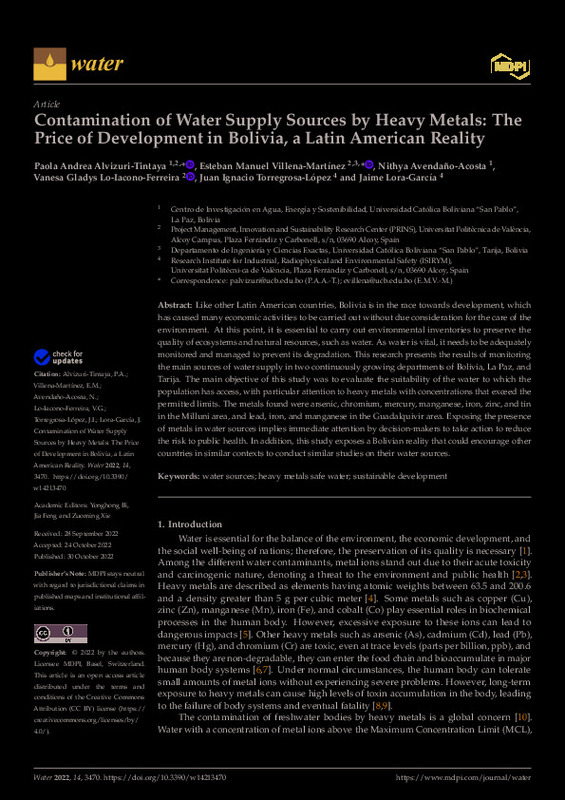JavaScript is disabled for your browser. Some features of this site may not work without it.
Buscar en RiuNet
Listar
Mi cuenta
Estadísticas
Ayuda RiuNet
Admin. UPV
Contamination of Water Supply Sources by Heavy Metals: The Price of Development in Bolivia, a Latin American Reality
Mostrar el registro sencillo del ítem
Ficheros en el ítem
| dc.contributor.author | Alvizuri-Tintaya, Paola Andrea
|
es_ES |
| dc.contributor.author | Villena-Martínez, Esteban Manuel
|
es_ES |
| dc.contributor.author | Avendaño-Acosta, Nihtya
|
es_ES |
| dc.contributor.author | Lo-Iacono-Ferreira, Vanesa G.
|
es_ES |
| dc.contributor.author | Torregrosa López, Juan Ignacio
|
es_ES |
| dc.contributor.author | Lora-García, Jaime
|
es_ES |
| dc.date.accessioned | 2023-06-09T18:01:54Z | |
| dc.date.available | 2023-06-09T18:01:54Z | |
| dc.date.issued | 2022-11 | es_ES |
| dc.identifier.issn | 2073-4441 | es_ES |
| dc.identifier.uri | http://hdl.handle.net/10251/194041 | |
| dc.description.abstract | [EN] Like other Latin American countries, Bolivia is in the race towards development, which has caused many economic activities to be carried out without due consideration for the care of the environment. At this point, it is essential to carry out environmental inventories to preserve the quality of ecosystems and natural resources, such as water. As water is vital, it needs to be adequately monitored and managed to prevent its degradation. This research presents the results of monitoring the main sources of water supply in two continuously growing departments of Bolivia, La Paz, and Tarija. The main objective of this study was to evaluate the suitability of the water to which the population has access, with particular attention to heavy metals with concentrations that exceed the permitted limits. The metals found were arsenic, chromium, mercury, manganese, iron, zinc, and tin in the Milluni area, and lead, iron, and manganese in the Guadalquivir area. Exposing the presence of metals in water sources implies immediate attention by decision-makers to take action to reduce the risk to public health. In addition, this study exposes a Bolivian reality that could encourage other countries in similar contexts to conduct similar studies on their water sources. | es_ES |
| dc.description.sponsorship | This work was supported by the Universidad Catolica Boliviana "San Pablo"-Academic Units of La Paz and Tarija, and by the Universitat Politecnica de Valencia through the ADSIDEO project. | es_ES |
| dc.language | Inglés | es_ES |
| dc.publisher | MDPI AG | es_ES |
| dc.relation.ispartof | Water | es_ES |
| dc.rights | Reconocimiento (by) | es_ES |
| dc.subject | Water sources | es_ES |
| dc.subject | Heavy metals safe water | es_ES |
| dc.subject | Sustainable development | es_ES |
| dc.subject.classification | INGENIERIA QUIMICA | es_ES |
| dc.subject.classification | PROYECTOS DE INGENIERIA | es_ES |
| dc.title | Contamination of Water Supply Sources by Heavy Metals: The Price of Development in Bolivia, a Latin American Reality | es_ES |
| dc.type | Artículo | es_ES |
| dc.identifier.doi | 10.3390/w14213470 | es_ES |
| dc.rights.accessRights | Abierto | es_ES |
| dc.contributor.affiliation | Universitat Politècnica de València. Escuela Politécnica Superior de Alcoy - Escola Politècnica Superior d'Alcoi | es_ES |
| dc.description.bibliographicCitation | Alvizuri-Tintaya, PA.; Villena-Martínez, EM.; Avendaño-Acosta, N.; Lo-Iacono-Ferreira, VG.; Torregrosa López, JI.; Lora-García, J. (2022). Contamination of Water Supply Sources by Heavy Metals: The Price of Development in Bolivia, a Latin American Reality. Water. 14(21):1-20. https://doi.org/10.3390/w14213470 | es_ES |
| dc.description.accrualMethod | S | es_ES |
| dc.relation.publisherversion | https://doi.org/10.3390/w14213470 | es_ES |
| dc.description.upvformatpinicio | 1 | es_ES |
| dc.description.upvformatpfin | 20 | es_ES |
| dc.type.version | info:eu-repo/semantics/publishedVersion | es_ES |
| dc.description.volume | 14 | es_ES |
| dc.description.issue | 21 | es_ES |
| dc.relation.pasarela | S\477638 | es_ES |
| dc.contributor.funder | Universitat Politècnica de València | es_ES |
| dc.contributor.funder | Universidad Católica Boliviana San Pablo | es_ES |
| dc.subject.ods | 06.- Garantizar la disponibilidad y la gestión sostenible del agua y el saneamiento para todos | es_ES |
| dc.subject.ods | 11.- Conseguir que las ciudades y los asentamientos humanos sean inclusivos, seguros, resilientes y sostenibles | es_ES |








